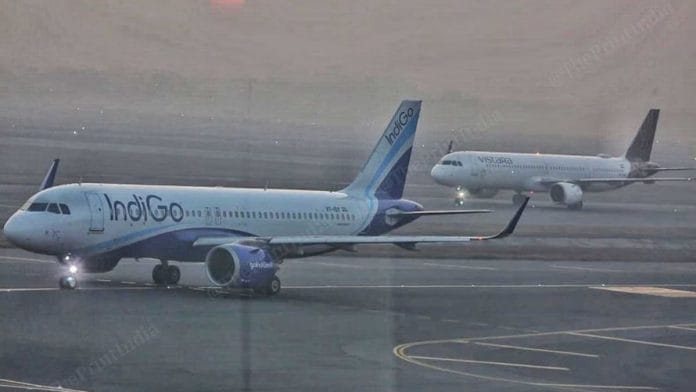New Delhi: The Aviation Ministry’s Bureau of Civil Aviation Security (BCAS) slapped a fine of Rs 1.2 crore on Indigo and Rs 60 lakh on Mumbai airport operator MIAL Wednesday, for violation of aviation security norms over the incident of passengers eating on the airport tarmac.
In addition, the Directorate General of Civil Aviation (DGCA) has imposed a fine of Rs 30 lakh on Mumbai International Airport Ltd (MIAL) for violating the “apron discipline as it jeopardized the safety of the passengers and the aircraft”.
Earlier this week, a video which went viral on social media, showed passengers sitting on the tarmac, and some were also seen eating there as soon as their flight landed after a long delay. The flight that took off from Goa could not land at Delhi airport due to dense fog, and was diverted to Mumbai Sunday.
Following this, BCAS Tuesday morning issued show cause notices to Indigo and Mumbai Airport for failure to observe due aviation security procedures. Separately, aviation regulator DGCA had also issued a notice to MIAL for violation of “para 5 of DGCA Air Safety circular 04 of 2007 that directs all agencies working at the airport not to permit walking on active apron”.
According to the orders issued Wednesday, replies submitted by Indigo and MIAL to the authorities were found to be unsatisfactory.
The penalty order by BCAS noted that Indigo failed to report the incident to it, did not screen passengers and their cabin baggage before allowing them to board the aircraft, did not deploy security staff in accordance with the scale of the incident, and also failed to respond to emergent situation in responsible and efficient manner.
The Mumbai airport too failed to report the incident to BCAS, the order stated, adding that the airport submitted false statement about deployment of security officers to cordon the area. In addition, while the security cameras were non-operative in the area, the airport made no alternate arrangement for surveillance of apron and runway. “…Mumbai International Airport Limited failed to implement security control measures committed in…its approved airport security programme…in a contingency situation arises at Mumbai airport.”
In addition to the penalty of Rs 60 lakh imposed by BCAS, MIAL has also been fined Rs 30 lakh by the DGCA “as they have failed to adhere to the safety requirements as laid down in the Air Safety Circular 04 of 2007″.
The DGCA Wednesday also imposed a penalty of Rs 30 lakh each on Air India and SpiceJet for failure to comply with pilot rostering requirements when operating flights in low visibility situations.
Also read: India’s Boeing planes audited twice recently — one was ‘satisfactory’, 2nd ‘found missing part’
Low visibility operations
Talking about the penalties imposed on Air India and SpiceJet, a DGCA official said, “Before the onset of fog season every year, DGCA holds meetings with aviation stakeholders such as airline operators and aerodrome operators. The meeting to check preparedness for low visibility operations was held in November. In the meeting, instructions regarding rostering of CAT II/III and LVTO [low visibility take-off] qualified pilots were issued to airline operators on low visibility operations and fog preparedness.”
CAT is a category of Instrument Landing System (ILS) – a means of navigation used in aviation for precision approach and landing operations during low visibility conditions due to fog and adverse weather conditions.
The official added that after analysing the flight delay/cancellation/diversion-related data for December 2023, it was found that SpiceJet and Air India did not roster CAT II/III and LVTO qualified pilots for some of the flights and thus they failed to comply with the directions issued.
DGCA issued show cause notices to the two airlines on 2 January, 2024, and their replies were “found unsatisfactory and both the airlines were imposed fine of Rs 30 lakh each for the violation and non-compliance under rule 133A of Aircraft Rules, 1937”, said the official.
(Edited by Poulomi Banerjee)
Also read: Delhi airport fully operationalises one runway for low-visibility landings, ‘war room’ set up






